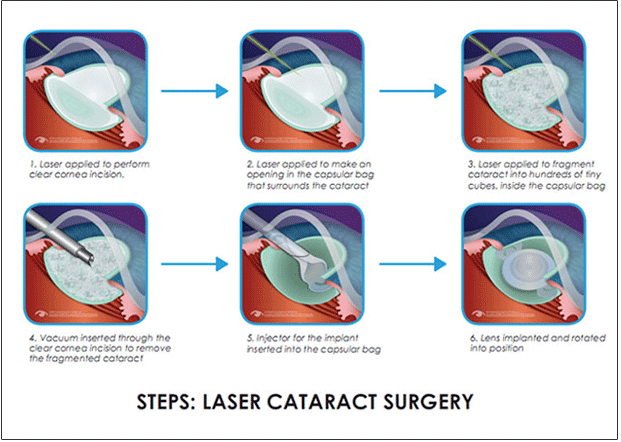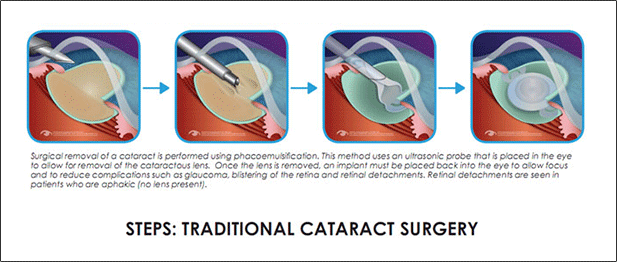LASER CATARACT
AT OCC EYECARE
A cataract is an opacity in the eye that results in impaired vision due to clouding of the lens. A normal eye has a clear lens able to refract light accurately to produce good vision. On the other hand, an eye with a cataract cannot focus light on the retina due to clouding of the lens. Consequently, there is blurred or double vision, poor night vision or blindness in extreme cases.
The mainstay of treatment of cataracts is surgery. The defective lens is removed and an artificial one inserted in its place. Laser Cataract Surgery is the most advanced technique for cataract extraction surgery. Using a series of lasers comparable to the lasers used in LASIK procedures, tiny incisions are made to the surface of the eye and the cataract is fragmented into hundreds of tiny pieces that are removed from the eye in a technique that has the least amount of collateral damage and risk of complications to the eye and the quickest visual recovery of any previous form of cataract surgery.
Advanced Technology Laser Cataract Surgery in Combination with Refractive Cataract Techniques allows for a level of visual care and recovery not seen before.
ADVANCED TECHNOLOGY
FEMTOSECOND or LASER CATARACT SURGERY
Catalys femtosecond cataract surgery is one of the most advanced methods for removing cataracts. This laser-guided computerized technique helps surgeons improve vision and decrease complications after surgery.
The Catalys system is safer for patients. The femtosecond laser uses much less energy to break up the cloudy lens than the older ultrasound techniques. This decreases the risk of swelling in the retina after surgery. Since the laser isn’t directed at the cornea, or clear tissue in front of the iris, it can’t cause a loss of cells that can create swelling and vision irregularities. In addition, the laser is computer-guided, so the bag, or capsule, holding the cataract is more stable with less risk of rupture. An intact capsule can hold the implant lens in place much more securely, which in turn optimizes vision.
The Liquid Optics interface is gentle on the eye. It creates a wide view for the surgeon so that he or she can see the entire front section of the eye without having to remove the lens. This improves comfort. The portion that touches the eye is called a dock. The Catalys system uses a soft dock, while other femtosecond lasers use a rigid one. As a result, this system applies almost no pressure on the eye surface. Increased intraocular pressure with the use of rigid docks would increase the risk of glaucoma complications.

The Integral Guidance system precisely maps the front structures of the eye. It also measures the thickness of the cornea and lens and locates the iris borders. The program processes all this information to create a 3-D model of the eye. The surgeon enters his or her treatment plan and confirms the map information. The computer calculates safety zones on the iris and lens capsule to prevent the femtosecond laser from touching these structures.
The map and data collected by the Integral Guidance system lets the surgeon calculate the exact power needed for the implant lens. It also allows him or her to place the implant more precisely inside the capsule than other ultrasound or femtosecond laser methods. Studies have shown that patients who have undergone the Catalys femtosecond cataract surgery procedure have better vision within the first seven days after surgery than patients who have had other types of cataract surgery.
MODERN TECHNOLOGY
PHACOEMULSIFICATION or ULTRASONIC CATARACT SURGERY
In modern terms, cataract surgery requires the removal of the lens material using phacoemulsification, a high frequency ultrasound tool.
Phacoemulsification or simply ‘Phaco’, involves a corneal incision wherein a small cut is made on the side of the cornea, the clear surface covering the front of the eye. Another hole is created in the capsule, the bag that surrounds the lens. Afterwards, a tiny probe utilizing ultrasound waves is used to soften and emulsify the cloudy lens so that it can be further aspirated or removed by suction. Newer cataract surgical
techniques including smaller incisions into the eye associated with less complications compared to what was seen previously.
After the removal of the cloudy lens, an artificial lens, called intraocular lens (IOL), is inserted to replace the natural lens.

